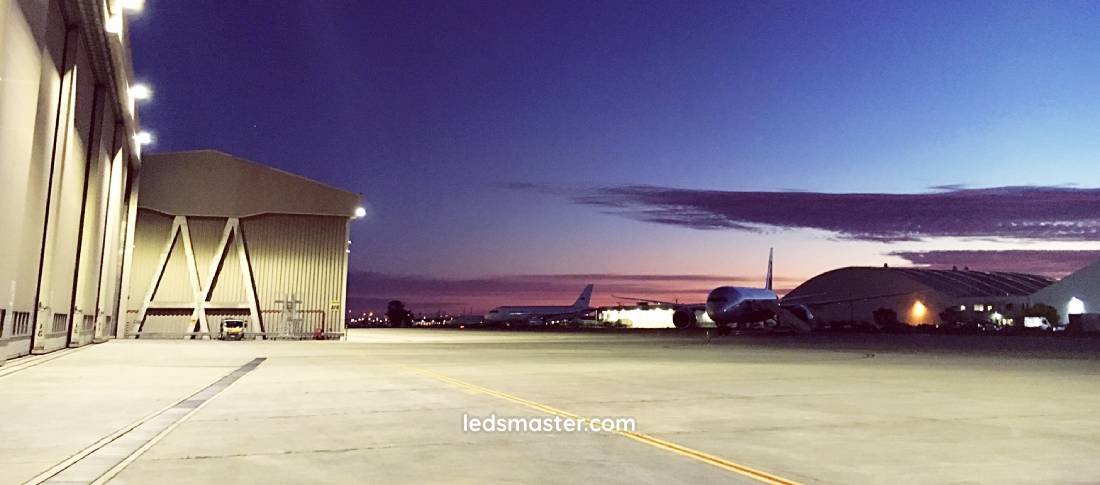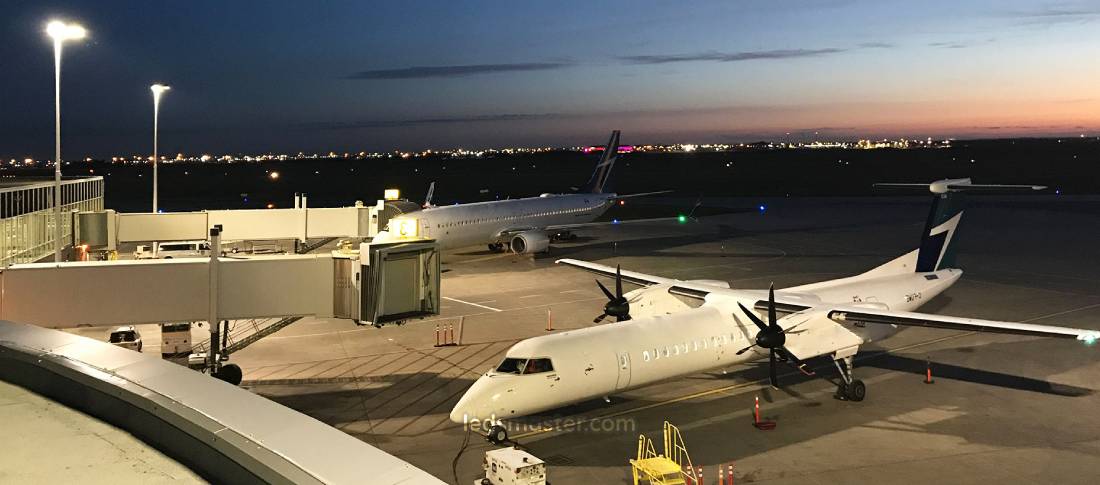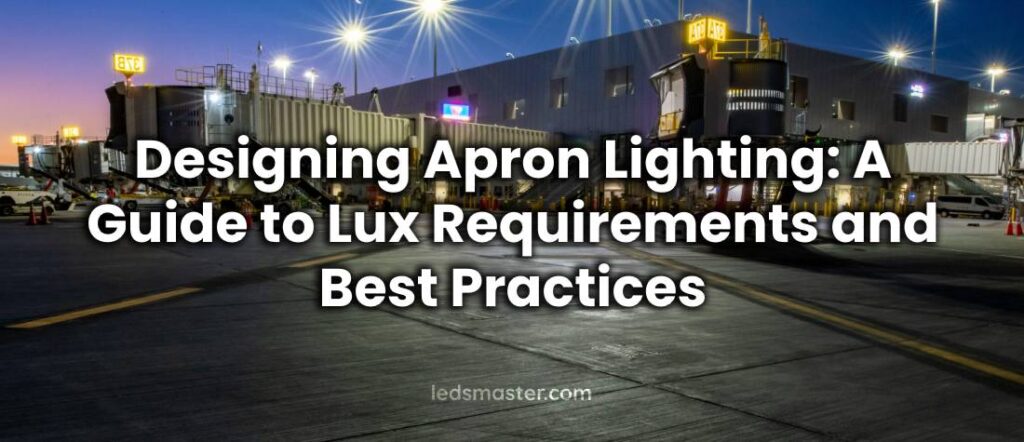Table of Contents
ToggleUnderstanding Apron Lighting
Apron lighting enhances visibility for ground crews, pilots, and maintenance teams. Proper illumination ensures that aircraft movements, refueling, and baggage handling occur without disruptions. Without adequate lighting, the risk of accidents increases, and operational efficiency declines.
Lighting on the apron must comply with established regulations to ensure uniformity and brightness. The design process involves determining the right lux levels, positioning light fixtures correctly, and minimizing glare. A well-lit apron reduces the chances of errors in aircraft servicing, making it easier for personnel to perform their tasks accurately.

Lux Requirements for Apron Lighting
| Apron Area | Recommended Lux Level | Purpose |
|---|---|---|
| Aircraft Parking Stands | 20 lux | Ensures visibility of parking guidance markings, obstacles, and taxi lines for pilots and ground crew. |
| Aircraft Servicing Zones (fueling stations, maintenance zones, engine inspection areas) | 30 lux | Provides adequate brightness for refueling, mechanical inspections, and minor repairs. |
| Passenger Boarding and Cargo Handling Areas | 50 lux | Supports efficient baggage handling, aircraft catering, and safe passenger movement. |
| Peripheral Apron Zones (vehicle pathways, storage areas) | 10 lux | Facilitates safe navigation of support vehicles and personnel in non-servicing areas. |
| High-Traffic and Maintenance Areas (wide-body aircraft handling, night-time inspections) | 75–100 lux | Ensures clear visibility for detailed aircraft inspections and maintenance work. |
| Adverse Weather Adjustments (fog, rain, snow) | Higher than standard values | Compensates for reduced natural visibility due to weather conditions. |
Recommended Lux Levels for Different Areas
Apron areas require specific lighting levels to support various ground operations, ensuring visibility for pilots, ground personnel, and air traffic controllers. Different activities demand varying degrees of brightness to accommodate safety and efficiency. The International Civil Aviation Organization (ICAO), in Annex 14 of its Aerodrome Design and Operations manual, provides recommended illuminance levels to standardize lighting across airports worldwide. These guidelines help maintain clear visibility in all apron zones, preventing accidents and improving operational performance.

Aircraft Parking Stands
Aircraft parking stands should have an average illuminance of 20 lux on the ground. This level allows pilots and ground crew members to identify parking guidance markings, obstacles, and taxi lines with clarity. Since this is an area where aircraft are stationary but may require pushback or movement preparation, the lighting must be sufficient to assist ground handlers in executing these operations safely. Poorly lit parking areas can increase the risk of misaligned parking, leading to inefficiencies in aircraft turnaround time.
Aircraft Servicing Zones
Areas where aircraft undergo active servicing, such as fueling stations, maintenance zones, and engine inspection areas, require a higher level of brightness, typically around 30 lux. These areas involve more intricate work, such as refueling, mechanical inspections, and minor repairs, all of which demand improved visibility to ensure accuracy. Proper lighting in these sections is particularly important for spotting leaks, detecting surface damages, and handling equipment safely. Inadequate lighting can lead to errors in fueling procedures, potentially compromising safety and efficiency.
Passenger Boarding and Cargo Handling Areas
Passenger boarding areas and cargo handling zones demand even greater illumination, with a minimum requirement of 50 lux. These zones experience continuous movement of passengers, baggage, and ground support equipment, requiring sufficient brightness to prevent mishandling of luggage, facilitate smooth aircraft catering, and ensure the safety of both passengers and workers. Higher lighting levels in these areas help improve efficiency by allowing workers to quickly locate and manage baggage while minimizing the chances of accidental injuries or misplaced cargo. Given that airports handle thousands of pieces of luggage daily, optimal visibility is essential for maintaining organization and reducing delays caused by baggage misplacement or loading errors.
Peripheral Apron Zones
Peripheral zones of the apron, which do not involve direct aircraft servicing, generally require lower illuminance levels of around 10 lux. These areas primarily accommodate vehicle movement, temporary storage of ground support equipment, and access pathways for maintenance personnel. While these locations do not require as much detailed visibility, lighting must still be adequate to allow for the safe navigation of support vehicles such as fuel trucks, catering vans, and maintenance carts. Ensuring that these pathways are sufficiently lit prevents collisions and reduces the likelihood of vehicle-related accidents.
High-Traffic and Maintenance Areas
At major international airports that operate under high traffic conditions or where night-time aircraft maintenance is frequently performed, apron lighting in certain zones may need to be increased to 75 to 100 lux. Airports that handle wide-body aircraft such as the Boeing 777 or Airbus A380 must ensure that apron lighting is bright enough to provide uniform illumination across the entire aircraft surface, including the fuselage, wings, and tail sections. Without sufficient brightness, ground crews may struggle to inspect aircraft components effectively, leading to potential oversights in pre-flight safety checks.
Adjustments for Environmental Conditions
The recommended values serve as a general guideline, but adjustments may be necessary based on environmental conditions, regional climate variations, and specific airport operational needs. Airports in regions prone to adverse weather conditions, such as frequent fog, heavy rainfall, or snowfall, may require higher lux levels to compensate for the reduced natural visibility. Foggy conditions, for instance, scatter light and decrease visibility, necessitating more intense illumination to maintain clarity for ground crews. Similarly, snow-covered surfaces reflect artificial lighting, potentially creating excessive glare, which must be managed through proper light fixture positioning and intensity adjustments.
Furthermore, airports that handle a higher volume of international flights with stringent security protocols may implement enhanced apron lighting in specific areas to assist with surveillance and monitoring. Advanced lighting systems that integrate adjustable intensity controls can help accommodate these variable lighting needs while optimizing energy efficiency. Implementing adaptable lighting solutions ensures that apron areas remain well-lit under different operational and environmental conditions, promoting both safety and efficiency in ground handling operations.
Uniformity and Distribution
In addition to achieving the correct lux levels, uniform lighting distribution is essential for maintaining consistent visibility. Shadows and dark spots can interfere with aircraft servicing and create hazards for ground personnel. To prevent this, the uniformity ratio, which measures the balance between minimum and average illuminance, should be at least 1:4. This ensures that no single area is too bright or too dim, reducing the risk of misjudgment or operational errors.
Light placement should be designed to provide an even spread across the apron, avoiding excessive brightness in some areas while leaving others underlit. Airports often use high-mast floodlights positioned at strategic locations to maximize coverage while minimizing shadows. The proper arrangement of these fixtures allows ground crews to work without relying on additional mobile lighting solutions, reducing operational delays and improving overall efficiency.
Light Source Selection for Apron Areas
LED vs. High-Pressure Sodium Lamps
Airports have traditionally relied on high-pressure sodium (HPS) lamps for apron lighting due to their affordability and high luminous efficacy. However, advancements in LED technology have led to a widespread transition to more energy-efficient and reliable lighting solutions. The primary advantage of LEDs lies in their superior color temperature, which typically ranges between 5000K and 6000K, closely resembling natural daylight. This cool white illumination enhances visibility, allowing ground crews to distinguish objects, markings, and equipment more clearly. In contrast, HPS lamps emit an orange-yellow glow with a color temperature of around 2000K, which reduces contrast and can make it more challenging to identify objects, especially under poor weather conditions.
Energy efficiency is another factor driving the shift toward LEDs. Compared to HPS lamps, LEDs consume up to 50 percent less energy, significantly reducing long-term operational costs. Additionally, the lifespan of LEDs exceeds 50,000 hours, whereas HPS lamps typically last between 15,000 and 24,000 hours. This extended lifespan minimizes maintenance frequency, reducing the need for frequent lamp replacements and minimizing disruptions to airport operations. Since replacing lighting fixtures on an apron requires specialized equipment and can interfere with aircraft movements, the lower maintenance requirements of LEDs offer a major advantage.
Beyond efficiency and longevity, LEDs provide instant illumination, unlike HPS lamps, which require a warm-up period before reaching full brightness. This characteristic is particularly useful in emergency situations where immediate full illumination is required. Additionally, LEDs offer better light uniformity, reducing shadows and dark spots that could hinder ground operations.
Due to these advantages, most modern apron lighting systems now integrate LED technology, ensuring improved visibility, lower maintenance costs, and greater energy efficiency. As airports continue prioritizing sustainability and operational reliability, LED lighting is expected to remain the preferred choice for apron illumination worldwide.
Placement and Height of Light Fixtures
Determining Pole Height
The height of lighting poles affects illumination quality and coverage. Standard apron lighting poles range from 15 to 35 meters, with taller poles used for large international airports. The goal is to cover the maximum surface area while minimizing glare for pilots and ground personnel. Lower poles may be installed near passenger boarding bridges or maintenance zones to avoid obstructions while ensuring adequate lighting in critical operational areas.
Avoiding Shadows and Glare
Strategic placement of light fixtures ensures that shadows do not form in areas where ground crews operate. Overlapping light beams from multiple fixtures help eliminate dark zones, ensuring that every section of the apron receives consistent illumination. Glare control is another factor in lighting placement. High-mounted floodlights must be positioned at angles that prevent direct exposure to pilots’ eyes. Excessive brightness can interfere with vision during taxiing, leading to safety concerns. Shields and louvers can be used to redirect light and reduce unwanted reflections on aircraft surfaces.
Energy Efficiency and Sustainability
Reducing Energy Consumption
Modern apron lighting systems incorporate smart controls that adjust brightness based on activity levels. Motion sensors and dimming technology allow lights to operate at full intensity only when needed, reducing unnecessary energy consumption. Switching to LED fixtures can result in an energy reduction of 30 to 60 percent, depending on usage patterns and operational requirements. Combined with solar-powered backup systems, airports can further decrease their reliance on conventional energy sources, reducing overall electricity costs.
Minimizing Light Pollution
Excessive lighting can contribute to skyglow, affecting nearby communities and ecosystems. Poorly directed lighting can also create visual disturbances for pilots approaching the airport at night. Directional lighting and shielding techniques ensure that light is focused on the apron area rather than dispersed into the sky. By carefully selecting light angles and using fixtures that limit upward light emission, airports can maintain effective illumination while minimizing environmental impact.
Compliance with International Standards
ICAO and FAA Regulations
The International Civil Aviation Organization (ICAO) and the Federal Aviation Administration (FAA) set the standards for apron lighting to ensure consistency and safety. ICAO Annex 14 specifies the recommended lux values and uniformity ratios for various apron zones, helping airports maintain adequate illumination levels. The FAA provides similar guidelines, with additional requirements for larger airports that handle high traffic volumes. Compliance with these standards helps airports create well-lit environments that meet operational and safety needs.
Local Adaptations and Weather Considerations
While international standards provide a baseline, adjustments may be required to accommodate specific weather conditions. Airports in regions with frequent fog, heavy rain, or snow may require higher lux levels to maintain visibility. Snow-covered surfaces can reflect light, leading to excessive brightness, which may need to be controlled using lower-intensity fixtures or adjustable lighting systems. Understanding local environmental conditions allows airports to fine-tune their lighting designs to ensure effective illumination throughout the year.
Conclusion
Designing apron lighting involves selecting appropriate lux levels, choosing efficient light sources, and ensuring proper fixture placement. By following international standards and integrating energy-saving solutions, airports can enhance visibility and streamline ground operations. Well-maintained lighting systems improve working conditions for ground crews, reduce operational risks, and contribute to overall efficiency.

